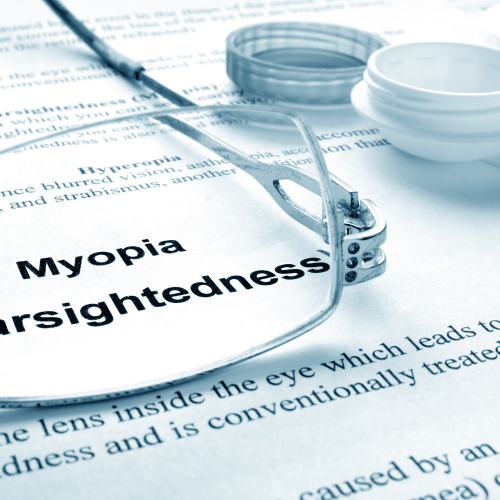What is High Myopia?


High myopia, also known as pathological or extreme nearsightedness, is a medical condition characterized by a severe level of nearsightedness. Nearsighted persons may see clearly when holding an object closer to their face.
Nearsightedness, or myopia, is a common refractive error, with corrective lens prescriptions measured in units known as diopters (D). High myopia is typically defined as having a vision prescription of -6.00 diopters or greater.
HIghly myopic individuals carry a heightened risk of eye diseases that can potentially lead to vision loss, making it crucial to manage myopia progression, particularly during childhood, before it advances to the high myopic stage.
Myopia Progression and Stabilization
Early development of myopia increases the likelihood of its progression and the eventual development of high myopia. While approximately 50% of individuals experience myopia stabilization by the age of 15, for others, progression can continue until around age 24. When nearsightedness reaches a prescription measurement of -6.00 D or higher, it is classified as “high.” Low and moderate myopia falls within the range of -0.25 D to -5.75 D.
Causes of High Nearsightedness
The primary cause of nearsightedness often associated with subtle changes in the shape of the eyeball. In cases of myopia, the eyeball tends to be slightly elongated, meaning it is longer from front to back than in individuals with normal vision.
This elongation results in light focusing in front of the retina, rather than directly on it. As a consequence, distant objects appear blurry to those with myopia, which necessitates corrective lenses to bring the focal point back onto the retina.
There is an association with eye shape and its propensity to affect the eyeball’s length contribute to the risk of associated eye conditions and the importance of proactive management to safeguard eye health. Regular eye examinations and appropriate management strategies are essential for individuals who are myopic to mitigate the potential risks and ensure the best possible vision and eye health.
Treatments
While there is no guaranteed cure for high myopia, several treatment approaches have been developed to slow or manage its progression. It’s essential to understand that the effectiveness of these treatments can vary from person to person, and treatment decisions should always be made in consultation with your eye care professional.
Here are some of the current treatment options for managing large degrees of nearsightedness:
Atropine Eye Drops: Low-dose atropine eye drops have shown promise in slowing the progression of myopia, including high myopia, particularly in children. Atropine works by temporarily paralyzing the eye’s focusing mechanism, which can reduce the stimulus for increased eye growth. The exact mechanism of how atropine slows myopia is still under investigation, but it has been found to be effective in many cases.
Orthokeratology (Ortho-K): Orthokeratology involves wearing specially designed rigid contact lenses overnight to reshape the cornea temporarily. This technique provides clear vision during the day and has been shown to slow myopia progression, especially in children. The reshaping of the cornea can reduce the overall refractive error.
Multifocal Contact Lenses and Eyeglasses: Multifocal contact lenses and eyeglasses are designed to provide clear vision at different distances. These optical corrections can help slow the progression of myopia, including high myopia, by reducing the eye’s ability to accommodate (focus) at near distances.
Increased Outdoor Time: Encouraging more outdoor activities, particularly in natural daylight, has been associated with a lower risk of developing nearsightedness and its progression. Spending time outdoors may help reduce the progression of myopia, even in cases of high myopia.
Lifestyle Modification: Reducing prolonged near work, taking regular breaks from close-up tasks, and maintaining good visual hygiene can be beneficial in managing myopia progression. It’s especially important for children to limit screen time and engage in outdoor activities.
Prescription Updates: Regular eye examinations are essential to monitor myopia progression and to ensure that the prescription is adjusted as needed to provide the best possible vision correction.
It’s important to note that while these treatments can help manage nearsightedness, they may not eliminate the condition entirely. The choice of treatment and its effectiveness depend on the specific circumstances. Early intervention and regular eye care are essential to minimize the risks associated with large amounts of nearsightedness, including an increased risk of eye diseases, retinal issues, and visual impairment.
Gregory Scimeca, M.D.
Ophthalmologist and Medical Director
The Eye Professionals
Our Locations
